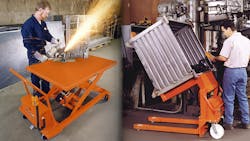Portable Lift Tables Take Manufacturing Flexibility to New Heights
A perfect storm of technologies is reshaping plant and distribution operations. Whether it’s 3D printing, the Industrial Internet of Things or the growth of e-commerce, new capabilities are raising customer expectations.
Build-to-order models and mass customization are becoming more common. This puts manufacturers under increasing pressure to increase flexibility in their processes. Mobility on the plant floor is one of the ways manufacturers can manage product variability more efficiently. Oftentimes, plant workers need to move parts or products from one cell to another to meet demand shifts.
“Customer needs seem to be changing at a more rapid pace,” says Rick daSilva, Presto ECOA Lifts national sales manager. “Manufacturers are more concerned about improving efficiencies. The ability to relocate equipment and have flexibility within their work cells is critical, especially when you get into certain industries that require frequent changes of packaging.”
Norton, Mass.-based Presto ECOA Lifts produces manually propelled lifts and stackers for in-plant applications. Portable lift tables are ideal for transporting loads to and from work cells, where they can be used as work platforms or raised and lowered to enable load transfer to tables or benches.
Traditionally, scissor lifts are anchored to the floor, or positioned within in a work cell, daSilva says. Typically, stationary lifts require workers to deliver or remove material from the lift table with a stacker or a forklift. Workers typically don’t move or relocate the lifts unless the operation or function within the work cell changes.
Flexible Solutions
But evolving customer needs mean manufacturers need to make work cells more adaptable. For example, a Big Three automaker needed a solution to stage automobile components prior to installation on the vehicle. The OEM installed Presto’s XP and XBP Series portable lifts to improve mobility and ergonomics stage subassemblies, according to daSilva.
“It allowed them to adjust their operation depending on the product mix of vehicles and gave them the ability to change their work cell quickly,” daSilva says.
The DC-powered XBP Series includes a hand pendant control that allows users to raise or lower loads by touching a button. It handles capacities of 1,000 to 2,000 lb., with lifting heights of up to 53.5 in. The XP Series units are compact scissor lifts that are suitable for use as portable workstations, machine feeding tables, and load transporters. It includes a foot pump that raises loads up to 1,500 lb. and heights up to 45 ¼ in.
XBP/WBP Series DC Electric Lift Tables offer capacities of 1,000, 1,500 and 2,000 lb.
XP Series at a Glance
- Foot-operated hydraulic pump
- Hand-release for lowering
- Two fixed and two swivel 5 x 2-in. phenolic casters
- XP24-20 and XP36-20 have 6-in. casters
- Hinged platform cylinder access
- Foot-operated floor lock
- Oversized and custom platforms available
- Optional casters styles available
- Custom designs available
XBP Series at a Glance
- 5 x 2-in. high-impact phenolic casters (two fixed, two swivel)
- Internal power unit
- Half-inch steel plate scissor legs
- 12V AGM cell battery
- Built-in 5-amp battery charger
- Optional power units available
- Hinged platform for cylinder/power unit access
- Foot-operated safety floor lock
- Gravity lowering
Safe Travels
Portable lifts also are helping distribution operations manage varying packaging needs. “In a third-party logistics operation, their customer may say we need this branding repackaged or redone,” daSilva says. “They have to adjust their operation to accommodate that request. They need the flexibility to relocate their operation and move things around.” For instance, one major third-party logistics (3PL) supplier needed ergonomics and the flexibility to adapt quickly to its customer’s requirements. The 3PL is using Presto’s P3-AA pneumatic load leveler with fork pockets to meet its needs.
P3-AA At a Glance:
- Works with loads of 400 to 4,500 lb.
- Automatically positions loads between 9 ½ and 27 ¾ in.
- Requires no electrical power
- Can be disconnected from shop air or compressor once airbag is inflated
- Small base allows workers to stand up close to the P3 at any position
- Stable design requires no floor lagging
- Built-in fork pockets facilitate relocation to multiple work areas
It allows users to load and unload pallets without stooping, stretching or walking. It automatically maintains pallets at a constant level and comfortable working height as workers add or remove layers of boxes. It can handle loads up to 4,500 lb. After airbag charging with shop air is complete, the P3-AA can be disconnected and moved to any location in the plant. It also includes a turntable top with anti-friction bearings that allow users to spin loads, so they’re always working from the near side without having to walk around the unit.
The ergonomically friendly features are critical as more manufacturers contend with an aging workforce, daSilva says. “The goal of the lift table is to keep the work at the optimal level for workers, who may be at different heights,” daSilva says.
In addition, accidents involving powered industrial trucks ranked among the top 10 most frequently cited safety hazards cited by the Occupational Safety and Health Administration (OSHA) in 2016. Portable lift tables allow users to transport material without a forklift. “Wheeling a lift table from the work cell to a load/unload area eliminates the safety risk caused by having a lift truck enter the work cell,” daSilva
About the Author

Jonathan Katz
Freelance Editor and Writer
Jonathan Katz, owner of JSK Communications, is a freelance writer with more than 15 years of experience in the publishing industry. He is the former managing editor for Cannabis Business Times and Cannabis Dispensary at GIE Media and a former managing editor of IndustryWeek magazine at Endeavor Business Media.
At IW, Katz covered a wide range of manufacturing topics, including automation, safety, facilities/plant operations and executive leadership.
Prior to freelancing, Katz served as a project manager for Content4Demand, a content marketing agency.





